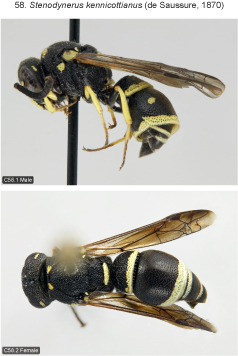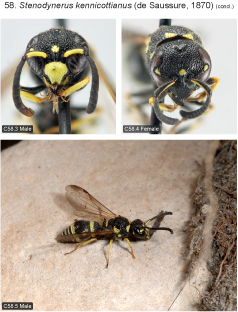
| Home | Table of contents | Keys | Species list | Glossary | Image data | PDF | Cite this article | Feedback | Updates |
Identification Atlas of the Vespidae (Hymenoptera, Aculeata) of the northeastern Nearctic region
CJAI 05, February 19, 2008
doi: 10.3752/cjai.2008.05
Matthias Buck, Stephen A. Marshall, and David K.B. Cheung
Department of Environmental Biology, University of Guelph, Guelph, Ontario, Canada N1G 2W1
Next species | Previous species | Key
58. Stenodynerus kennicottianus (de Saussure, 1870)
Figs B2.10; B7.16, 37, 67; C58.1–5.

|

|
Species recognition. A combination of characters is required to diagnose this species: clypeal apex emarginate (not truncate as in S. anormis-group), interocellar area at most weakly tuberculate (moderately to strongly tuberculate in S. blepharus and related species), pronotal carina interrupted medially (entire in several other species), tergum 3 with complete apical fascia (absent or interrupted in several other species).
Variation. Fore wing length 4.5–6.0 mm (♂♂), 5.0–6.5 mm (♀♀). Thickening of apical margin of tergum 2 up to 0.6x mid ocellar diameter (male) or up to 0.5x mid ocellar diameter (female). Pale markings of body varying from pale to bright yellow in male (usually paler on posterior metasomal segments), always pale yellow in female. Female clypeus usually black, rarely with a small, pale, dorsomedian spot, in western specimens sometimes with three spots (dorsomedian and -lateral), rarely connected to form a crescent-shaped dorsal mark; male clypeus sometimes with black apical margin and small, black, evanescent discal spot(s), which is rarely large and connected to black ventral margin. Interantennal spot restricted to area above interantennal prominence in female, in western males rarely narrowly extending to clypeus. Pale spot along inner orbit restricted to eye emargination or extending ventrally to clypeus in male, in the latter case almost always interrupted at level of antennal socket. Postocular spot often small, rarely absent in male. Scutum with posteromedial spot present in some specimens from western Canada (more frequently in females), but usually small and evanescent. Spot on upper mesopleuron sometimes small, rarely absent in male. Propodeal dorsum often with a pair of pale spots in female, rarely present in male. Female terga 1–5 and male terga 1–(5)6 with apical fasciae, the fascia of tergum almost always 3 complete, very rarely narrowly interrupted at middle. One aberrant male with bright yellow markings from Rondeau Prov. Pk., ON, has terga 3–7 almost completely black except for evanescent median remnant of fascia on tergum 4. Tergum 2 with discal spots of sometimes present (more often in female) but usually small. Sternum 2 with complete apical fascia; sternum 3 with apicolateral spots in female, in male varying from completely black (very rare) to fasciate but then fascia usually interrupted laterally; sternum 4 in male sometimes with median or lateral remnant(s) of apical fascia.
Distribution. Transcontinental in Canada and the U.S., except the southwest; the western ssp. antheus (Cameron, 1908) occurs east to WY, UT and NM (Krombein 1979). We have examined Canadian specimens from QC, ON, MB, SK, AB, BC and NT.
Biology. Not recorded previously. On September, 3rd 2004 one of us (S.A.M.) observed several specimens (males, see Fig. 58.5, and probably females) at the vertical sandy banks of a small river at Michael’s Bay, Manitoulin I., ON. Some specimens (supposedly females) were seen entering small holes in the sandy bank. The absence of rearing records from trap nests etc. and this new observation seems to indicate that S. kennicottianus is a ground-nesting species.
Next species | Previous species | Key
| Home | Table of contents | Keys | Species list | Glossary | Image data | PDF | Cite this article | Feedback | Updates |
